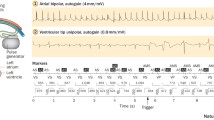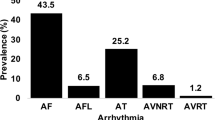Abstract
Aims
The aim of the study was to evaluate the performance of pacemakers (PM) atrial tachyarrhythmia (AT)-sensing algorithms in sinus node dysfunction (SND) patients with DDDR pacing programmed with a fixed long atrioventricular (AV) delay.
Methods
In a prospective study, a total of 60 patients with SND were implanted with a dual-chamber PM with two different algorithms for detection of ATs. The study was done with a 3 month data collection period retrieved from the memory of PM and with a 7 day external Holter recording period.
Results
In 13 of 16 (81 %) patients whose Holter recording revealed the presence of ATs, episodes of AT sensing were retrieved from the PM memory with electrograms verifications, confirming that the devices had detected the ATs. Very short ATs seen in Holter recordings were missed by the PM with three patients. However, with all these patients after 3 months of follow up period, there were recognized periods of ATs by the PM. With ten (17 %) patients, there were intermittent periods of undersensing by the PM although continuous atrial fibrillation (AF) was seen in the Holter recording. Retrograde conduction caused false AT detection due to repetitive non-reentrant ventriculoatrial synchronous rhythm (RNRVAS) in six (25 %) of the 24 patients with retrograde conduction.
Conclusions
Even with long AV delay, ATs can be accurately identified. However, transient undersensing of continuous AF and non-detection of very short AT episodes can still occur. Programming a long AV delay predisposes to RNRVAS which can cause false AT detection and symptoms in SND patients who have retrograde conduction.

Similar content being viewed by others
References
Vardas, P. E., Auricchio, A., Blanc, J. J., Daubert, J. C., Drexler, H., Ector, H., et al. (2007). European Society of Cardiology; European Heart Rhythm Association. Guidelines for cardiac pacing and cardiac resynchronization therapy. The task force for cardiac pacing and cardiac resynchronization therapy of the European Society of cardiology. Developed in collaboration with the European Heart Rhythm Association. Europace, 9, 959–998.
Nowak, B., McMeekin, J., Knops, M., Wille, B., Schröder, E., Moro, C., et al. (2005). Stored EGM in Pulsarmax II and discovery II study group. Validation of dual-chamber pacemaker diagnostic data using dual-channel stored electrograms. Pacing and Clinical Electrophysiology, 28, 620–629.
Glotzer, T. V., Hellkamp, A. S., Zimmerman, J., Sweeney, M. O., Yee, R., Marinchak, R., et al. (2003). MOST investigators. Atrial high rate episodes detected by pacemaker diagnostics predict death and stroke: report of the atrial diagnostics ancillary study of the mode selection trial (MOST). Circulation, 107, 1614–1619.
Tse, H. F., & Lau, C. P. (2005). Prevalence and clinical implications of atrial fibrillation episodes detected by pacemaker in patients with sick sinus syndrome. Heart, 91, 362–364.
De Voogt, W. G., van Hemel, N. M., van de Bos, A. A., Koistinen, J., & Fast, J. H. (2006). Verification of pacemaker automatic mode switching for the detection of atrial fibrillation and atrial tachycardia with Holter recording. Europace, 8, 950–961.
Kolb, C., Wille, B., Maurer, D., Schuchert, A., Weber, R., Schibgilla, V., et al. (2006). FFS-test study group.Management of far-field R wave sensing for the avoidance of inappropriate mode switch in dual-chamber pacemakers: results of the FFS-test study. Journal of Cardiovascular Electrophysiology, 17, 992–997.
Barold, S. S., & Levine, P. A. (2001). Pacemaker repetetive nonreentrant ventriculoatrial synchronous rhythm. A review. Journal of Interventional Cardiac Electrophysiology, 5, 45–58.
Sweeney, M. O., Hellkamp, A. S., Ellenbogen, K. A., Greenspon, A. J., Freedman, R. A., Lee, K. L., et al. (2003). Mode selection trial investigators. Adverse effect of ventricular pacing on heart failure and atrial fibrillation among patients with normal baseline QRS duration in a clinical trial of pacemaker therapy for sinus node dysfunction. Circulation, 107, 2932–2937.
Nielsen, J. C., Kristensen, L., Andersen, H. R., Mortensen, P. T., Pedersen, O. L., & Pedersen, A. K. (2003). A randomized comparison of atrial and dual-chamber pacing in 177 consecutive patients with sick sinus syndrome: echocardiographic and clinical outcome. Journal of the American College of Cardiology, 42, 614–623.
Olshansky, B., Day, J. D., Lerew, D. R., Brown, S., & Stolen, K. Q. (2007). INTRINSIC RV study investigators. Eliminating right ventricular pacing may not be best for patients requiring implantable cardioverter-defibrillators. Heart Rhythm, 4, 886–891.
Nitardy, A., Langreck, H., Dietz, R., & Stockburger, M. (2009). Reduction of right ventricular pacing in patients with sinus node dysfunction through programming a long atrioventricular delay along with the DDIR mode. Clinical Research in Cardiology, 98, 25–32.
Kohno, R., Abe, H., Oginosawa, Y., Tamura, M., Takeuchi, M., Nagatomo, T., et al. (2011). Reliability and characteristics of atrial tachyarrhythmias detection in dual-chamber pacemakers. Circulation Journal, 75, 1090–1097.
Schuller, H., & Brandt, J. (1991). The pacemaker syndrome: old and new causes. Clinical Cardiology, 14, 336–340.
Dennis, M. J., & Sparks, P. B. (2004). Pacemaker mediated tachycardia as a complication of the autointrinsic conduction search function. Pacing and Clinical Electrophysiology, 27, 824–826.
Velasquez-Castano, J. C., & Lloyd, M. S. (2009). Palpitations after a pacemaker generator exchange: a new algorithm-induced cause of endless loop tachycardia. Heart Rhythm, 6, 1380–1382.
Pakarinen, S., Vitikainen, A.-M., Corbucci, G., & Toivonen, L. (2010). Morphological analysis of sinus and retrograde atrial waves detected through a permanent pacemaker atrial lead. Journal of Interventional Cardiac Electrophysiology, 29, 191–198.
Acknowledgments
This study was supported by St. Jude Medical.
Conflict of interest
Sami Pakarinen received a fee from St. Jude Medical for designing this study. The authors have no other financial relationship with the sponsor.
Author information
Authors and Affiliations
Corresponding author
Rights and permissions
About this article
Cite this article
Pakarinen, S., Toivonen, L. Performance of atrial tachyarrhythmia-sensing algorithms in dual-chamber pacing using a fixed long AV delay in patients with sinus node dysfunction. J Interv Card Electrophysiol 35, 207–213 (2012). https://doi.org/10.1007/s10840-012-9691-4
Received:
Accepted:
Published:
Issue Date:
DOI: https://doi.org/10.1007/s10840-012-9691-4




